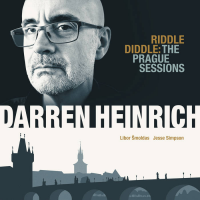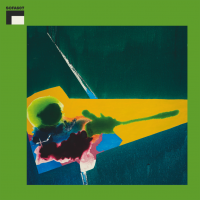Home » Jazz Articles » Multiple Reviews » Verve Originals: Gato Barbieri / Paul Desmond / Gerry Mu...
Verve Originals: Gato Barbieri / Paul Desmond / Gerry Mulligan / Wes Montgomery
 Gato Barbieri
Gato Barbieri
Chapter Three: Viva Emiliano Zapata
Impulse!
2009 (1974)
The fiery going on incantatory Chapter Three: Viva Emiliano Zapata was the third of four South American-themed albums the Argentinean tenor saxophonist Gato Barbieri made for Impulse! in 1973-74, following a Grammy nomination for his soundtrack to Bernardo Bertolucci's 1972 hit movie, Last Tango In Paris. Almost literally overnight, the success of that project elevated Barbieri from being a well-regarded but relatively obscure jazz musician—recording for the tiny independent labels ESP-Disk and Flying Dutchman—into something approaching a household name.
Post-Tango, Barbieri became a "property," who could name his own price and fulfill a few personal dreams. The latter included a longstanding wish to sign to his formative influence, saxophonist John Coltrane's label; his price for doing so was the expensive Chapter series. Three of the four albums required recording budgets far in excess of the prevailing norm. Chapter One: Latin America (Impulse!, 1973) was recorded with native Argentinean and Brazilian musicians in Buenos Aires and Rio de Janeiro; for Chapter Two: Hasta Siempre (Impulse!, 1974), an Argentinean group was flown to Los Angeles to rehearse and record.
Chapter Four: Alive In New York (Impulse!, 1975), made with a small group, required a more modest spend (six days of recording at the Bottom Line club). But Chapter Three, though also recorded in New York, was another high roller, featuring a 20-piece Latin jazz orchestra led by the Cuban arranger/bandleader, Chico O'Farrill. Impulse!'s investment was amply returned—Chapter One sold around 100,000 copies—but all four albums were also artistic triumphs, adventurous and atmospheric blends of jazz and South American musics.
Chapter Three is rooted in mambo, with a little tango ("Milonga Triste") and cha-cha ("Lluvia Azul") thrown in. In the 1970s, Barbieri's composing (four of the six tracks here are originals) and improvising styles were closely related to saxophonist Pharoah Sanders' contemporaneous work, with Sanders' fondness for Eastern musics replaced by Barbieri's South American heritage. The two Coltrane disciples had each evolved a simplified, less dissonant interpretation of their mentor's blueprint: both played with a heavily vocalized tone (Barbieri almost continuously) and favored catchy tunes played over reiterative, trance-inducing vamp or modal structures, and both featured expanded percussion sections brought well forward in the mix. On Chapter Three, Barbieri is center stage practically throughout, stating the themes and exploring them with ever increasing fervor while riding O'Farrill's rich, brass and percussion heavy charts.
Lyrical and groove-centric, Chapter Three, like One, Two and Four, is the "new thing" without angst and an early harbinger of world jazz.
 Gerry Mulligan / Paul Desmond Quartet
Gerry Mulligan / Paul Desmond Quartet
Blues In Time
Verve
2009 (1957)
Saxophone magic of another kind, from a yet earlier age. In 1957, alto player Paul Desmond and baritone player Gerry Mulligan were headlining stars: Desmond as a member of pianist Dave Brubeck's quartet, Mulligan leading his own groups. Each was an influential stylist in what was variously and erroneously labeled "the cool school" or "West Coast sound," making Blues In Time a summit meeting.
Even before the success of Brubeck's Time Out (Columbia, 1959) and its Desmond-composed hit single, "Take Five," Brubeck had disliked Desmond recording with groups which included a pianist (it's said that at some point Desmond had a clause added to his contract forbidding it). So the saxophonist's opportunities to work as a guest artist were limited. Co-leading a piano-less album with Mulligan—who had made his name with piano-less lineups, most famously with trumpeter Chet Baker—got round that difficulty.
Pretty much everything else about the partnership was perfect too, from the complementary pitches of the two saxophones through the melodious but gutsy improvising styles of the two players. Crucially, each musician was also at ease with spontaneous counterpoint: Mulligan's contrapuntal soloing with Baker had been a signature sound of his 1952-53 quartet, and Brubeck had taken Desmond some distance along the same path.
Blues In Time, made with Mulligan sidemen Joe Benjamin (bass) and Dave Bailey (drums), includes three originals apiece from Mulligan and Desmond and one standard ("Body And Soul"). The vibe is sunny, sprightly and inventive and Mulligan and Desmond would return to it with equal charm on Two Of A Mind (RCA, 1962).
 Wes Montgomery
Wes Montgomery
Down Here On The Ground
A&M
2009 (1968)
A minor item in guitarist Wes Montgomery's canon, Down Here On The Ground was made only a few months before his early death from a heart attack and several light years after iconic albums like Incredible Jazz Guitar (Riverside, 1960) and So Much Guitar (Riverside, 1961), with which he had first made his name. Wooed away from Riverside by producer Creed Taylor, first to Verve in 1964 and then to A&M in 1967, Montgomery had since mid decade been pursuing a radio-friendly style verging on, and sometimes actually crossing over into, easy listening.
Down Here On The Ground is typical of Montgomery's later work: tracks are short, soloing is brief or non-existent, the groove is smooth, and the sweetening (flutes, oboes, a string quartet) prominent. Montgomery himself never recorded a less than beautiful note, of course, which means that even on purely commercial outings like this there's no pain and even some gold to be found.
Tracks and Personnel
Chapter Three: Viva Emiliano Zapata
Tracks: Milonga Triste; Lluvia Azul; El Sublime; La Padrida; Cuando Vuelva A Tu Lado (What A Difference A Day Makes); Viva Emiliano Zapata.
Personnel: Gato Barbieri: tenor saxophone; Victor Paz: trumpet; Bob McCoy: trumpet; Randy Brecker: trumpet; Alan Rubin: trumpet, flugelhorn; Ray Alonge: French horn; Jimmy Buffington: French horn; Buddy Morrow: trombone; Alan Raph: bass trombone; Howard Johnson: tuba, flugelhorn, bass clarinet, baritone saxophone; Seldon Powell: piccolo, flute, alto flute, alto saxophone, baritone saxophone; Eddie Martinez: piano, Fender Rhodes; George Davis: electric guitar, acoustic guitar; Paul Metzke: electric guitar; Ron Carter: acoustic bass, electric bass; Grady Tate: drums; Ray Armando: Latin percussion; Luis Mangual: Latin percussion; Ray Mantilla: Latin percussion; Portinho: Latin percussion; Chico O'Farrill: arranger, conductor.
Blues In Time
Tracks: Blues In Time; Body And Soul; Standstill; Line For Lyons; Wintersong; Battle Hymn Of The Republican; Fall Out.
Personnel: Gerry Mulligan: baritone saxophone; Paul Desmond: alto saxophone; Joe Benjamin: bass; Dave Bailey: drums.
Down Here On The Ground
Tracks: Wind Song; Georgia On My Mind; The Other Man's Grass Is Always Greener; Down Here On The Ground; Up And At It; Goin' To Detroit; I Say A Little Prayer For You; When I Look Into Your Eyes; Know It All; Theme From The Fox.
Personnel: Wes Montgomery: electric guitar; Hubert Laws: flute; George Marge: flute; Romeo Penque: flute, oboe; Herbie Hancock: piano; Mike Mainieri: vibraphone; Gene Orloff: violin; Raul Poliakin: violin; Emanuel Vardi: viola; George Ricci: cello; Ron Carter: bass; Grady Tate: drums; Bobby Rosengarden: percussion; Ray Barretto: percussion.
Tags
PREVIOUS / NEXT
Support All About Jazz
 All About Jazz has been a pillar of jazz since 1995, championing it as an art form and, more importantly, supporting the musicians who make it. Our enduring commitment has made "AAJ" one of the most culturally important websites of its kind, read by hundreds of thousands of fans, musicians and industry figures every month.
All About Jazz has been a pillar of jazz since 1995, championing it as an art form and, more importantly, supporting the musicians who make it. Our enduring commitment has made "AAJ" one of the most culturally important websites of its kind, read by hundreds of thousands of fans, musicians and industry figures every month.


















